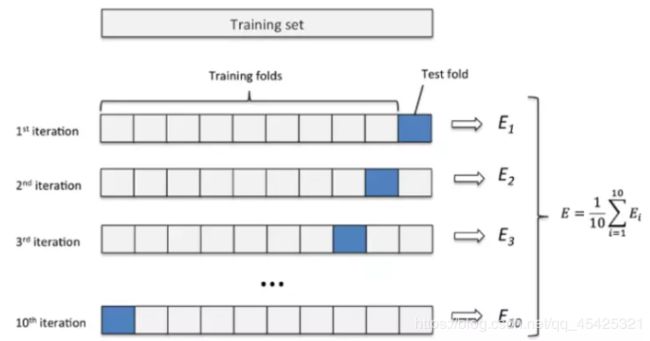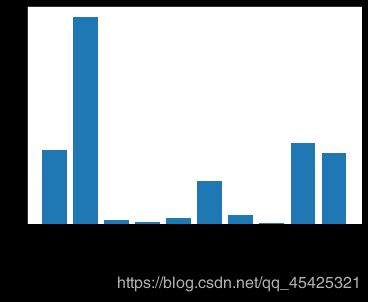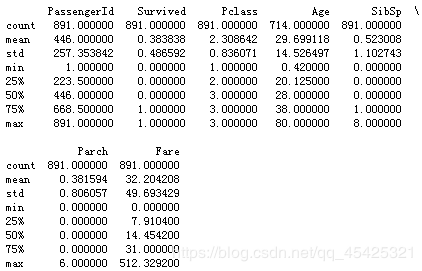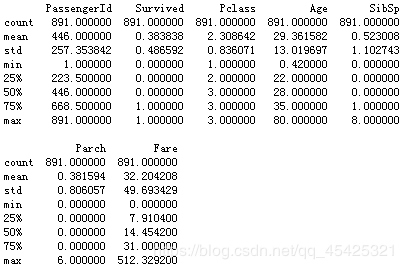14案例实战:泰坦尼克获救预测(线性回归、逻辑回归、随机森林、Kfold交叉验证、Bagging类型集成算法)
唐宇迪《python数据分析与机器学习实战》学习笔记
14案例实战:泰坦尼克获救预测
文章目录
- 一、数据观察与预处理
- 1.1 数据导入
- 1.2 缺失值填充
- 1.3 字符量映射为数值量
- 二、模型训练及预测
- 2.1 .线性回归模型
- 2.2 逻辑回归模型
- 2.3 随机森林
- 三、特征创造及重要性衡量(feature_selection)
- 3.1 特征创造
- 3.2 特征重要性判断
- 四、集成算法
- 4.1 梯度增强+逻辑回归
- 4.2 使用测试数据预测
目的:将之前学过的机器学习算法应用在实际场景中,这里使用的是泰坦尼克号获救数据
一、数据观察与预处理
数据如下:1列为编号,2列为是否存活(标签),然后分别为船舱等级、姓名、性别、年龄、船上多少个亲人(SibSp)、船上你的老人+孩子多少个(Parch)、船票编号(Ticket)、船票价格(Fare)、船舱位(Cabin缺失多)、上船码头(Embarked)。

1.1 数据导入
数据导入,并统计一下每个特征:发现age有缺失值。(备注:现在传入的数据,为训练数据集)
import pandas
titanic = pandas.read_csv('titanic_train.csv')
print(titanic.describe())
1.2 缺失值填充
这里利用平均年龄对缺失值进行填充:
titanic['Age'] = titanic['Age'].fillna(titanic['Age'].median())
print(titanic.describe())
1.3 字符量映射为数值量
print (titanic['Sex'].unique()) #看一下这列有几种可能性,这里两种
titanic.loc[titanic['Sex']== 'male','Sex']=0 #男士映射为0
titanic.loc[titanic['Sex']=='female','Sex']=1 #女士映射为1
[‘male’ ‘female’]
print (titanic['Embarked'].unique())
titanic['Embarked'] = titanic['Embarked'].fillna('S') #众数填充
titanic.loc[titanic['Embarked']== 'S','Embarked']=0
titanic.loc[titanic['Embarked']=='C','Embarked']=1
titanic.loc[titanic['Embarked']=='Q','Embarked']=2
[‘S’ ‘C’ ‘Q’ nan]
二、模型训练及预测
下面我们分别用线性模型、逻辑回归、随机森林这三种机器学习算法模型来分析这个案例,就是分析生存率
2.1 .线性回归模型
首次使用线性回归算法进行分类,数据交叉验证分割为3份,每份轮流作验证集,其他作训练集
from sklearn.linear_model import LinearRegression
#导入线性回归
from sklearn.model_selection import KFold
#交叉验证,把训练数据集分成三份,1份验证2份训练模型,最后取平均值
predictors = ['Pclass', 'Sex', 'Age', 'SibSp', 'Parch', 'Fare', 'Embarked']
#要给我的分类器哪些特征
alg = LinearRegression()
# kf = KFold(titanic.shape[0], n_folds=3, random_state=1) 写法错误已被弃用
kf = KFold(n_splits=3,shuffle=False, random_state=1)#shuffle每次划分时是否洗牌 random_state随机种子数
predictions = [] #装预测结果
#for train,test in kf 写法错误已被弃用
for train, test in kf.split(titanic): #3份轮流当测试和验证
#得到训练集的特征与标签
train_predictors = (titanic[predictors].iloc[train,:])#特征,用iloc选出作为训练集标签的行
train_target = titanic['Survived'].iloc[train] #标签
alg.fit(train_predictors,train_target) #建模
#传入验证集的特征值,进行预测
test_predictions = alg.predict(titanic[predictors].iloc[test,:])
#每次加入结果(一大堆概率值),共三次,组成拥有3个数组的数组数据。
predictions.append(test_predictions)
接着算出线性回归准确率,将刚才得到的预测值中的3个数组合并,然后以0.5为分界值将结果映射,计算准确率
import numpy as np
#这些预测在三个独立的numpy数组中。把它们连接成一个。
predictions = np.concatenate(predictions,axis=0)
# 映射成分类结果,计算准确率
predictions[predictions > .5] = 1
predictions[predictions <= .5] = 0
#用预测对的/总的
accuracy = sum(predictions==titanic['Survived'])/len(predictions)
print(accuracy)
0.7037037037037037
二分类问题,瞎猜都50%,因此这个准确率并不高
2.2 逻辑回归模型
from sklearn.model_selection import cross_val_score #k 折交叉验证,切三份每份轮流当验证
from sklearn.linear_model import LogisticRegression #逻辑回归模型传入
alg = LogisticRegression(random_state=1)
scores = cross_val_score(alg, titanic[predictors], titanic["Survived"], cv=3) #cv为可迭代的次数
print(scores.mean())
0.7081930415263749
结果略微变好
为了便于理解 上面cross_val_score的K折法这里传入下图10折参考:

2.3 随机森林
以上都是用交叉分类后的训练数据集进行分类,实际中应该对测试数据集进行分类。
接下来传入测试数据集,重复刚才在训练集上的填充、映射操作。
titanic_test = pandas.read_csv("test.csv")
titanic_test["Age"] = titanic_test["Age"].fillna(titanic["Age"].median())
titanic_test["Fare"] = titanic_test["Fare"].fillna(titanic_test["Fare"].median())
titanic_test.loc[titanic_test["Sex"] == "male", "Sex"] = 0
titanic_test.loc[titanic_test["Sex"] == "female", "Sex"] = 1
titanic_test["Embarked"] = titanic_test["Embarked"].fillna("S")
titanic_test.loc[titanic_test["Embarked"] == "S", "Embarked"] = 0
titanic_test.loc[titanic_test["Embarked"] == "C", "Embarked"] = 1
titanic_test.loc[titanic_test["Embarked"] == "Q", "Embarked"] = 2
通过上面线性回归和逻辑回归发现效果似乎都不太理想,因此尝试一下随机森林,随机森林一般比前两者效果都要好,这里需要着重注意一下随机森林的参数变化
# 导入需要用的库
from sklearn.model_selection import cross_val_score
from sklearn.model_selection import KFold
from sklearn.ensemble import RandomForestClassifier
#需要使用的特征
predictors = ["Pclass", "Sex", "Age", "SibSp", "Parch", "Fare", "Embarked"]
#构造树模型
alg = RandomForestClassifier(random_state=1,
n_estimators=10, #构造10棵树
min_samples_split=2,#最小切分点,2个时不切了
min_samples_leaf=1) #叶子节点最少个数
#一般不希望树的高度太高,可能过拟合,切得太碎可能因为噪音点而切
#交叉验证,3折
kf = KFold(n_splits=3, shuffle=False, random_state=1)
#得到分值(准确率),每次交叉验证得到分值,这里得到3个
scores = cross_val_score(alg, titanic[predictors], titanic["Survived"], cv=kf)
print(scores.mean())#取三个平均
0.7856341189674523
这里结果有所提升,但是还是不理想,因此通过参数调节对模型进行优化
随机森林参数调节
最需要调整建立多少棵树,因此这里试一下建立100棵树 (后面两个参数也可以调节)
alg = RandomForestClassifier(random_state=1,
n_estimators=100,
min_samples_split=4,
min_samples_leaf=2)
kf = KFold(n_splits=3, shuffle=False, random_state=1)
scores = cross_val_score(alg, titanic[predictors], titanic["Survived"], cv=kf)
print(scores.mean())
0.8148148148148148
结果又有所提升,假设此时模型优化得差不多了,前面三种方法得到的结果最高也不理想,达到了准确率瓶颈,想要继续优化,此时就回归数据本身。影响分类器最多的还是输入数据本身。刚才输入特征有限,接下来构造新特征,比如:家庭成员+名字长度。
三、特征创造及重要性衡量(feature_selection)
本质是:通过加入噪音值前后的错误率的差值来判断特征值的重要程度。
3.1 特征创造
titanic["FamilySize"] = titanic["SibSp"] + titanic["Parch"] #船上多少个亲人+船上你的老人+孩子多少个
titanic["NameLength"] = titanic["Name"].apply(lambda x: len(x)) #用名字长度创造一列
这里观察名字列发现还带有一些称谓,比如博士、小姐等等,代表了一定的社会身份,因此这里也提取出来。

import re #正则表达式
# 构造一个函数去获取
def get_title(name):
# 使用正则表达式搜索
#称谓如Mr.通常由大写字母和小写字母组成,并以句号结尾,把格式写成正则表达式并搜索
title_search = re.search(' ([A-Za-z]+)\.', name) #,A-Z所有的大写字母,a-z所有的小写字母,+表示出现≥1次,\.匹配句号
# 如果称谓存在就提取,然后返回值
if title_search:
return title_search.group(1)
return ""
# 这里获取所有的称谓,并打印每一个称谓出现数量
titles = titanic["Name"].apply(get_title)
print(pandas.value_counts(titles))
# 将称谓字符串映射为整数。有些少见的称谓就干脆和其他一起映射
title_mapping = {"Mr": 1, "Miss": 2, "Mrs": 3, "Master": 4, "Dr": 5, "Rev": 6, "Major": 7, "Col": 7, "Mlle": 8, "Mme": 8, "Don": 9, "Lady": 10, "Countess": 10, "Jonkheer": 10, "Sir": 9, "Capt": 7, "Ms": 2}
for k, v in title_mapping.items():
titles[titles == k] = v
# 看一下转换结果
print(pandas.value_counts(titles))
# 添加一列装入数据
titanic["Title"] = titles
Mr 517
Miss 182
Mrs 125
Master 40
Dr 7
Rev 6
Col 2
Mlle 2
Major 2
Lady 1
Sir 1
Jonkheer 1
Ms 1
Capt 1
Mme 1
Don 1
Countess 1
Name: Name, dtype: int64
1 517
2 183
3 125
4 40
5 7
6 6
7 5
10 3
8 3
9 2
Name: Name, dtype: int64
3.2 特征重要性判断
现在弄出了一大堆特征,这里选择出最有价值的特征,利用前面提到的随机森林特征重要性判断。
例如:12345特征建立随机森林模型,得到一个错误率erro1;判断某个特征重要性,就用噪音值替换该特征,然后得到一个错误率erro2,比较两个错误率,看重要性。
import numpy as np
from sklearn.feature_selection import SelectKBest, f_classif
import matplotlib.pyplot as plt
predictors = ["Pclass", "Sex", "Age", "SibSp", "Parch", "Fare", "Embarked",
"FamilySize","Title", "NameLength"]
# 建立特征选择模型,传入特征及标签
selector = SelectKBest(f_classif, k=5)
selector.fit(titanic[predictors], titanic["Survived"])
# 获取每个特性的原始p值,并通过log函数转换为分数
scores = -np.log10(selector.pvalues_)
# 可视化展示,“Pclass”、“Sex”、“Title”和“Fare”最佳
plt.bar(range(len(predictors)), scores)
plt.xticks(range(len(predictors)), predictors, rotation='vertical')
plt.show()
# 只选择4个最好的特征
predictors = ["Pclass", "Sex", "Fare", "Title"]
#建立随机森林
alg = RandomForestClassifier(random_state=1, n_estimators=50,min_samples_split=8,min_samples_leaf=4)
kf = KFold(n_splits=3, shuffle=False, random_state=1)
scores = cross_val_score(alg, titanic[predictors], titanic["Survived"], cv=kf)
print(scores.mean())

0.819304152637486
从图中分析出,4个最重要特征为船舱等级、性别、船票、称谓,取出来用,剔除不重要项。
上面都是单个分类器,这里引进集成算法
四、集成算法
4.1 梯度增强+逻辑回归
from sklearn.ensemble import GradientBoostingClassifier
import numpy as np
#这里集成两个算法,在逻辑回归中使用了更线性的预测器,以及梯度增强分类器。
algorithms = [
[GradientBoostingClassifier(random_state=1, n_estimators=25, max_depth=3), ["Pclass", "Sex", "Age", "Fare", "Embarked", "FamilySize", "Title",]],
[LogisticRegression(random_state=1,solver='liblinear'), ["Pclass", "Sex", "Fare", "FamilySize", "Title", "Age", "Embarked"]]
] #solver优化算法选择参数,liblinear指用坐标轴下降法来迭代优化损失函数
# 交叉验证
kf = KFold(n_splits=3,shuffle=False, random_state=1)
predictions = [] #装最终预测分类值
for train, test in kf.split(titanic):
train_target = titanic["Survived"].iloc[train]#训练集标签
full_test_predictions = []#装两个分类器预测值
# 对每个折叠中的每个算法进行预测
for alg, predictors in algorithms:
# 训练集训练模型
alg.fit(titanic[predictors].iloc[train,:], train_target)
# astype(float)是将数据aframe转换为所有浮点数并避免sklearn错误所必需的。
test_predictions = alg.predict_proba(titanic[predictors].iloc[test,:].astype(float))[:,1]
full_test_predictions.append(test_predictions)
# 两个分类器取平均结果
test_predictions = (full_test_predictions[0] + full_test_predictions[1]) / 2
# 映射结果值
test_predictions[test_predictions <= .5] = 0
test_predictions[test_predictions > .5] = 1
predictions.append(test_predictions)
# 将所有的预测放在一个数组中
predictions = np.concatenate(predictions, axis=0)
# 精度计算
accuracy = sum(predictions == titanic["Survived"]) / len(predictions)
print(accuracy)
0.8215488215488216
4.2 使用测试数据预测
代入测试数据集来进行预测(不过在测试数据集里面没有"Survived"这一列,就只能进行预测了)
数据预处理
titles = titanic_test["Name"].apply(get_title)
title_mapping = {"Mr": 1, "Miss": 2, "Mrs": 3, "Master": 4, "Dr": 5, "Rev": 6, "Major": 7, "Col": 7, "Mlle": 8, "Mme": 8, "Don": 9, "Lady": 10, "Countess": 10, "Jonkheer": 10, "Sir": 9, "Capt": 7, "Ms": 2, "Dona": 10}
for k,v in title_mapping.items():
titles[titles == k] = v
titanic_test["Title"] = titles
# 检查每个唯一标题的计数
print(pandas.value_counts(titanic_test["Title"]))
# 现在,我们添加family size列
titanic_test["FamilySize"] = titanic_test["SibSp"] + titanic_test["Parch"]
1 240
2 79
3 72
4 21
7 2
6 2
10 1
5 1
Name: Title, dtype: int64
predictors = ["Pclass", "Sex", "Age", "Fare", "Embarked", "FamilySize", "Title"]
algorithms = [ [GradientBoostingClassifier(random_state=1, n_estimators=25, max_depth=3), predictors],
[LogisticRegression(random_state=1), ["Pclass", "Sex", "Fare", "FamilySize", "Title", "Age", "Embarked"]]]
full_predictions = []
for alg, predictors in algorithms:
# 使用完整的训练数据拟合算法
alg.fit(titanic[predictors], titanic["Survived"])
# 使用测试数据集进行预测。我们必须将所有列转换为浮点数以避免错误
predictions = alg.predict_proba(titanic_test[predictors].astype(float))[:,1]
predictions[predictions <= .5] = 0
predictions[predictions > .5] = 1
full_predictions.append(predictions)
# 梯度增强分类器能够产生更好的预测,因此我们对其进行了更高的加权
#predictions = (full_predictions[0] * 3 + full_predictions[1]) / 4
predictions
array([0., 0., 0., 0., 1., 0., 1., 0., 1., 0., 0., 0., 1., 0., 1., 1., 0.,
0., 1., 1., 0., 0., 1., 1., 1., 0., 1., 0., 0., 0., 0., 0., 0., 0.,
0., 0., 1., 1., 0., 0., 0., 0., 0., 1., 1., 0., 0., 0., 1., 0., 0.,
0., 1., 1., 0., 0., 0., 0., 0., 1., 0., 0., 0., 1., 1., 1., 1., 0.,
0., 1., 1., 0., 1., 0., 1., 1., 0., 1., 0., 1., 0., 0., 0., 0., 0.,
0., 1., 1., 1., 1., 1., 0., 1., 0., 1., 0., 1., 0., 1., 0., 1., 0.,
0., 0., 1., 0., 0., 0., 0., 0., 0., 1., 1., 1., 1., 0., 0., 1., 0.,
1., 1., 0., 1., 0., 0., 1., 0., 1., 0., 0., 0., 1., 0., 0., 0., 0.,
0., 0., 1., 0., 0., 1., 0., 0., 0., 0., 0., 0., 0., 0., 1., 0., 0.,
0., 0., 0., 1., 1., 0., 1., 1., 0., 1., 0., 0., 1., 0., 0., 1., 1.,
0., 0., 0., 0., 0., 1., 1., 0., 1., 1., 0., 0., 1., 0., 1., 0., 1.,
0., 0., 0., 0., 0., 0., 0., 1., 0., 1., 1., 0., 1., 1., 0., 1., 1.,
0., 0., 1., 0., 1., 0., 0., 0., 0., 1., 0., 0., 1., 0., 1., 0., 1.,
0., 1., 0., 1., 1., 0., 1., 0., 0., 0., 1., 0., 0., 0., 0., 0., 0.,
1., 1., 1., 1., 0., 0., 0., 0., 1., 0., 1., 1., 1., 0., 1., 0., 0.,
0., 0., 0., 1., 0., 0., 0., 1., 1., 0., 0., 0., 0., 1., 0., 0., 0.,
1., 1., 0., 1., 0., 0., 0., 0., 1., 0., 1., 1., 1., 0., 0., 0., 0.,
0., 0., 1., 0., 0., 0., 0., 1., 0., 0., 0., 0., 0., 0., 0., 1., 1.,
0., 0., 0., 0., 0., 0., 0., 1., 1., 1., 0., 0., 0., 0., 0., 0., 0.,
0., 1., 0., 1., 0., 0., 0., 1., 0., 0., 1., 0., 0., 0., 0., 0., 0.,
0., 0., 0., 1., 0., 1., 0., 1., 0., 1., 1., 0., 0., 0., 1., 0., 1.,
0., 0., 1., 0., 1., 1., 0., 1., 0., 0., 1., 1., 0., 0., 1., 0., 0.,
1., 1., 1., 0., 0., 0., 0., 0., 1., 1., 0., 1., 0., 0., 0., 0., 1.,
1., 0., 0., 0., 1., 0., 1., 0., 0., 1., 0., 1., 1., 0., 0., 0., 0.,
1., 1., 1., 1., 1., 0., 1., 0., 0., 0.])

